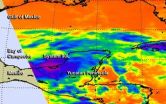(Press-News.org) NASA and NOAA satellites are gathering visible, infrared, microwave and radar data on a persistent tropical low pressure area in the southwestern Bay of Campeche. System 90L now has a 50 percent chance for development, according to the National Hurricane Center and continues to drop large amounts of rainfall over southeastern Mexico.
The Atmospheric Infrared Sounder (AIRS) instrument aboard NASA's Aqua satellite gathered infrared data on the developing low on June 5 at 18:59 UTC (2:59 p.m. EDT).
Basically, AIRS looks at the infrared region of the spectrum. In a spectrum, infrared light has a wavelength just greater than that of the red end of the visible light spectrum but less than that of microwaves. Looking at infrared light, instruments are able to detect temperature and AIRS gathered temperature information about the heights of the tops of the thunderstorms that make up System 90L (a tropical cyclone or developing low pressure area can consist of hundreds of thunderstorms).
AIRS data revealed that the tropical low had cloud-top temperatures near -63F (-52C). Cloud top temperatures that cold indicate thunderstorms strong enough with the potential to drop heavy rainfall, and the National Hurricane Center warned about flash flooding and mudslides in the Yucatan peninsula and southeastern Mexico.
The low has been hanging around the Bay of Campeche since June 2. When it developed it was an elongated and broad area of low pressure with a near zero chance of development. Today, June 6, that's changed.
At 1200 UTC (8 a.m. EDT) on June 6, System 90L was sitting in the Bay of Campeche, but has moved west of its position from earlier in the week. System 90L was located near 19.3 north latitude and 94.5 west longitude.
The National Hurricane Center (NHC) noted that shower and thunderstorm activity associated with System 90L has changed little in organization overnight from June 5 to June 6. NHC uses visible and infrared imagery from the two GOES satellites to monitor the changes in System 90L in addition to data from several NASA satellites.
NOAA's GOES-East satellite sits in a fixed orbit in space and captures visible and infrared imagery of all weather over the eastern U.S. and Atlantic Ocean. A visible image from GOES-East on June 6 at 7:30 a.m. EDT, showed developing System 90L's center is near the rounded area of clouds. The image was made by NASA/NOAA's GOES Project at NASA's Goddard Space Flight Center in Greenbelt, Md. System 90L is sitting off the coasts of the Mexican states of Veracruz and Tabasco.
The NHC Discussion noted that regardless of tropical cyclone formation, this disturbance could produce heavy rains, along with life-threatening flash floods and mud slides, over portions of southeastern and eastern Mexico during the next few days.
The Mexican Weather Service (MWS) noted in an advisory on June 6 that System 90L has the potential to bring rain to the states of Central, South and Southeast parts of the country, as well as in the Yucatan Peninsula. The MWS forecasts between 150 to 250 mm (~6 to ~10 inches) of rainfall for the state of Veracruz; between 75 to 150 mm (~3 to ~6 inches) for the Guerrero, Oaxaca, Puebla y Chiapas, and rainfall between 50 to 75 mm (~2 to ~3 inches) for México, Michoacán, Hidalgo, Morelos, Tabasco, Distrito Federal y Tlaxcala. For updated forecasts (in Spanish) from the MWS, visit: http://smn.cna.gob.mx.
INFORMATION:
Text credit: Rob Gutro
NASA's Goddard Space Flight Center END
NASA and NOAA satellites eyeing Mexico's tropical soaker for development
2014-06-06
ELSE PRESS RELEASES FROM THIS DATE:
Study shows health policy researchers lack confidence in social media for communication
2014-06-06
Philadelphia – Though Twitter boats 645 million users across the world, only 14 percent of health policy researchers reported using Twitter – and approximately 20 percent used blogs and Facebook – to communicate their research findings over the past year, according to a new study from the Perelman School of Medicine at the University of Pennsylvania. In contrast, sixty-five percent used traditional media channels, such as press releases or media interviews. While participants believed that social media can be an effective way to communicate research findings, many lacked ...
Evolution of a bimetallic nanocatalyst
2014-06-06
Atomic-scale snapshots of a bimetallic nanoparticle catalyst in action have provided insights that could help improve the industrial process by which fuels and chemicals are synthesized from natural gas, coal or plant biomass. A multi-national lab collaboration led by researchers with the U.S. Department of Energy (DOE)'s Lawrence Berkeley National Laboratory (Berkeley Lab) has taken the most detailed look ever at the evolution of platinum/cobalt bimetallic nanoparticles during reactions in oxygen and hydrogen gases.
"Using in situ aberration-corrected transmission electron ...
Tougher penalties credited for fewer casualties among young male drivers
2014-06-06
VIDEO:
A new Western University study led by Dr. Evelyn Vingilis has found a significant decline in speeding-related fatalities and injuries among young men in Ontario since the province's tough extreme...
Click here for more information.
A new study out of Western University (London, Canada) has found a significant decline in speeding-related fatalities and injuries among young men in Ontario since the province's tough extreme speeding and aggressive driving laws were introduced ...
Endoscope with an oxygen sensor detects pancreatic cancer
2014-06-06
JACKSONVILLE, Fla. — June 6, 3014 — An optical blood oxygen sensor attached to an endoscope is able to identify pancreatic cancer in patients via a simple lendoscopic procedure, according to researchers at Mayo Clinic in Florida.
The study, published in GIE: Gastrointestinal Endoscopy, shows that the device, which acts like the well-known clothespin-type finger clip used to measure blood oxygen in patients, has a sensitivity of 92 percent and a specificity of 86 percent.
MULTIMEDIA ALERT: Video and audio are available for download on the Mayo Clinic News Network.
That ...
Magnetic moment of the proton measured with unprecedented precision
2014-06-06
One of the biggest riddles in physics is the apparent imbalance between matter and antimatter in our universe. To date, there is no explanation as to why matter and antimatter failed to completely annihilate one another immediately after the big bang and how the surplus matter was created that went on to form the universe as we know it. Experiments conducted at Johannes Gutenberg University Mainz (JGU) have contributed towards a resolution of this problem. For the first time a direct and high-precision measurement of the magnetic moment of the proton has been conducted ...
A new way to make laser-like beams using 250x less power
2014-06-06
ANN ARBOR – With precarious particles called polaritons that straddle the worlds of light and matter, University of Michigan researchers have demonstrated a new, practical and potentially more efficient way to make a coherent laser-like beam.
They have made what's believed to be the first polariton laser that is fueled by electrical current as opposed to light, and also works at room temperature, rather than way below zero.
Those attributes make the device the most real-world ready of the handful of polariton lasers ever developed. It represents a milestone like none ...
New species of ancient chirping giant pill-millipedes from Madagascar already threatened
2014-06-06
An international team of researchers comprised of Thomas Wesener, Museum Koenig, Bonn, Daniel Le, Field Museum, Chicago and Stephanie Loria, American Museum of Natural History, New York, discovered seven new species of chirping giant pill-millipedes on Madagascar. The study was published in the open access journal ZooKeys.
The species discovered all belong to the genus Sphaeromimus, which is Latin for 'small ball animal'. However, the designation 'small' is not always true for the members of the genus as one of the newly discovered species surprises with a size larger ...
Probiotics prevent deadly complications of liver disease
2014-06-06
Bethesda, MD (June 6, 2014) — Probiotics are effective in preventing hepatic encephalopathy in patients with cirrhosis of the liver, according to a new study in Clinical Gastroenterology and Hepatology, the official clinical practice journal of the American Gastroenterological Association. Hepatic encephalopathy is a deterioration of brain function that is a serious complication of liver disease.
"This rigorous new research finds that probiotics modify the gut microbiota to prevent hepatic encephalopathy in patients with cirrhosis of the liver," said David W. Victor III, ...
Shatterproof screens that save smartphones
2014-06-06
University of Akron polymer scientists have developed a transparent electrode that could change the face of smartphones, literally, by making their displays shatterproof.
In a recently published scientific paper, researchers demonstrated how a transparent layer of electrodes on a polymer surface could be extraordinarily tough and flexible, withstanding repeated scotch tape peeling and bending tests. This could revolutionize and replace conventional touchscreens, according to Yu Zhu, UA assistant professor of polymer science. Currently used coatings made of indium tin ...
Breakthrough study solves plant sex mystery
2014-06-06
A team of biologists from the University of Leicester has solved a mystery surrounding how plants have sex.
The researchers have discovered a pair of proteins made by flowering plants that are vital for the production of the sperm present within each pollen grain.
Scientists already knew that flowering plants, in contrast to animals, require not one, but two sperm cells for successful fertilisation: one to join with the egg cell to produce the embryo and one to join with a second cell to produce the nutrient-rich endosperm inside the seed.
The mystery of this 'double ...







